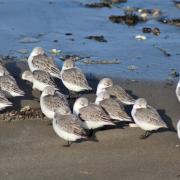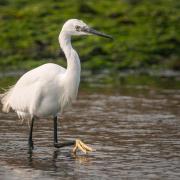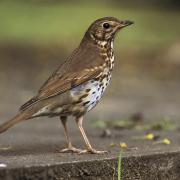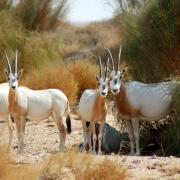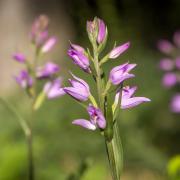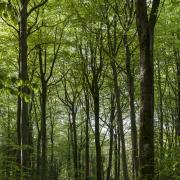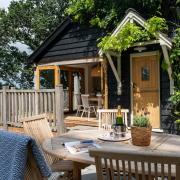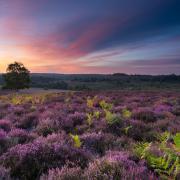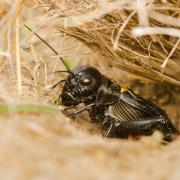News, views and advice from the Hampshire and Isle of Wight Wildlife Trust
Create a winning wildlife garden
The Hampshire and Isle of Wight Wildlife Trust has launched a new award scheme to find wildlife-friendly gardens in Hampshire.Our gardens are extremely important for wildlife. Not only can they provide food and shelter for a huge range of plants and animals, but they can form natural ‘bridges’ between built-up and open areas which allow wildlife more freedom of movement. Gardens can also provide particular habitats that may be missing in your local area such as ponds and suitable hibernation or nesting sites.
What does the scheme involve?There are lots of simple things you can do in your garden to make it wildlife friendly, and even small changes can make your garden more attractive for wildlife. Whether it is planting some nectar-rich wildflowers, creating a compost heap, putting out some bird feeders or building a pond, you can make a real difference to local wildlife.
Want to join the scheme?The Wildlife Trust has introduced a new scheme to formally recognise the efforts of wildlife friendly gardeners across Hampshire. If you can demonstrate that your garden is a haven for wildlife, you will be awarded with a certificate, a weatherproof plaque that you can display in your wildlife friendly garden.
Want more information?If you would like some further information about the scheme and how to submit your entry, along with hints and tips of how to make your garden more wildlife friendly, visit www.hwt.org.uk, call 01489 774 406 or email wildlifegardening@hwt.org.uk.
April's wild events
When: Wednesday, April 7What: Keyhaven Birdwatch. Another in the regular autumn, winter and spring series of short walks with Steve Lankester to see the wintering birds of the Keyhaven and Pennington marshes. Where: Meet at the car park at Keyhaven (Map ref. SZ 306 915). Time: 9.30am-12.30pm. Contact: Steve on 01590 682421. Cost: �2.
When: Saturday, April 10What: Dawn Chorus Walk and Breakfast. Pete Potts, HCC Countryside Ranger, will lead the walk. A cooked breakfast at the end to look forward to. Where: Meet at the Cricklemede entrance to The Moors (Map ref. SU 558 169). Time: 5.30am. Contact: Booking is essential Jane Gentry on 01489 890961. Cost: adults �3, children �1 including breakfast.
When: Wednesday, April 14What: Living Landscapes in the Winchester Area. A brief Annual Meeting followed by a beautifully illustrated talk on Winchester’s wonderful wild spaces by David Rumble, the Trust’s Head of Conservation for our district. Where: Badger Farm Community Centre, at the far end of Sainsbury’s car park, Winchester (Map ref. SU 462 275). Time: 7.45pm. Contact: Lorraine Martin on 01962 861182. Cost: �2.50 including refreshments.When: Monday, April 19What: New Impressions of Spring. An illustrated talk by David Poynter ARPS, about springtime around the rivers Test and Itchen; birds, butterflies, insects and landscapes. Where: Crosfield Hall, Broadwater Road, Romsey. Time: 7.30pm. Contact: Theo Jarman on 01794 514825. Cost: �2.
When: Sunday, April 25What: Bluebells at Morgaston Woods. Join Ruth Cairns for a walk through Morgaston Woods. Where: The Vyne (National Trust) car park near the entrance. Time: 10am. Contact: Ruth on 01256 326364. Cost: �1.50.
Wildline
Q When is the best time to cut back my hedge?
A By cutting back at least half of the new season’s growth each winter you will encourage lower branches to grow and create a shorter, denser hedge. By pruning the hedge so that the sides are tapered and narrower at the top you will allow rainwater and sunlight to reach the lower leaves and the base soil. A major factor to consider when undertaking any cutting or pruning in your garden is whether there may be birds nesting in that area. If possible, try to avoid cutting during the nesting season between early March and the end of August as the Wildlife and Countryside Act 1981 states that ‘it is an offence to intentionally take, damage or destroy the nest of any wild bird while it is in use or being built.’
Q We often see bats in our garden in the evening. Do you have a design we could follow to build our own bat box?
A Bat boxes are an excellent way of providing artificial roosts and encouraging bats to an area where there may be a lack of natural nest sites. Bat boxes should be placed as high as possible in an area sheltered from wind and that has exposure to sunlight throughout most of the day. Placing boxes along hedge or tree lines may also be beneficial as bats often use these for navigation. The Bat Conservation Trust has created a step-by-step fact sheet for making your own bat box which WildLine can provide.
Call WildLineIf you have a question for WildLine, here’s how to get in touch:Tel. 01489 774 446Email: WildLine@hwt.org.uk Web www.hwt.org.ukWrite to WildLine, Hampshire and Isle of Wight Wildlife Trust, Beechcroft House, Vicarage Lane, Curdridge, Hampshire SO32 2DP





